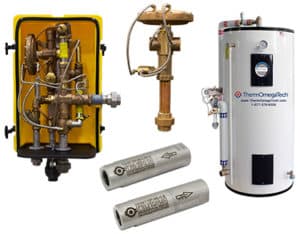
Please take a moment and visit CSEMag.com’s voting page here and select CircuitSolver or DTV as your vote for Product of the Year. You may vote as often as you like.

Please take a moment and visit CSEMag.com’s voting page here and select CircuitSolver or DTV as your vote for Product of the Year. You may vote as often as you like.
We came across this article on return temperatures. It addresses some key issues in regards to domestic hot water balancing. Our new CircuitSolver™ can be a great way to fix, and even eliminate problems with hot water delivery.
The Importance of Return Temperatures
Delivery & Return Temperatures are the two most critical numbers; these are the temperatures available to the residents at the beginning and at the end of the hot water loop. Too hot is unsafe, too low is unacceptable for cleaning or comfort.
Low Return Temperature is commonly ignored because diagnosis can be tedious and it doesn’t seem like a dangerous problem. Wrong.
Do not ignore a Low Return Temperature Warning! A drop in temperature from delivery to return means that:
Return Temperature is like a canary in a coal mine: if there is anything wrong with the hot water system it is often the first alarm to go off. If your return temperature chart isn’t in the pink, your boilers are probably in fine order. But, if you’re seeing a lot of pink, it’s time to fix things before your residents start seeing red
Special thanks to EDC Technologies, Inc. for letting us re-post this.

Fred was born on February 17, 1946 in San Antonio, TX to Charles Earl Pirkle and Zutella Bones Pirkle. He lived in San Antonio throughout his childhood and graduated from Harlandale High School in 1964.
In 1970 Fred received a B.S. from the Department of Industrial Technology at Sam Houston State University in Huntsville, TX and in 1972 he received a Masters degree from the same university.
Social Responsibility
“Shotgun Fred’s Guru Crew” The Walk to Defeat ALS!!
Fred Pirkle, aka “Shotgun Fred”, founded ThermOmegaTech® in 1982.
Since then, he has patented more than 20 products, including the first temperature control device for charcoal grills/cookers – hence “The BBQ Guru” was born in 2004.
In April 2011, Fred was diagnosed with ALS. As his friends and family are well aware, he is a fighter and continues to fight the disease every day. ALS, or amyotrophic lateral sclerosis, is a progressive neurodegenerative disease that affects nerve cells in the brain and spinal cord.
In Fred’s honor, and in an effort to help support patient service programs and ALS research, ThermOmegaTech® and The BBQ Guru have joined forces with the ALS Association.
We are a corporate sponsor of and have formed a team, “Shotgun Fred’s Guru Crew.” On Saturday, November 5th, we participated in our first Walk to Defeat ALS.
For more information about ALS, Social Responsibility, or this event please go to www.alsphiladelphia.org

OSHA Standard 1910.151(c)
Need a refresher on the OSHA standard for safety showers and eyewash stations?
http://www.osha.gov/pls/oshaweb/owadisp.show_document?p_id=9806&p_table=STANDARDS
http://www.osha.gov/pls/oshaweb/owadisp.show_document?p_table=INTERPRETATIONS&p_id=24288
Will OSHA cite a facility for not following the recommendations as stated in ANSI standard Z358.1-1990? Specifically, will an OSHA inspector cite a facility for not supplying tempered water to an emergency eyewash and shower?
http://www.osha.gov/pls/oshaweb/owadisp.show_document?p_table=INTERPRETATIONS&p_id=24119
Imagine the following scenario: One of your plant floor employees has just had their eye or skin exposed to a caustic chemical, which needs to be immediately flushed from contact. Per OSHA regulations, you should already have an eye washing station or emergency shower on the plant floor, which the employee should be familiar with. In an instant, they need the proper water, at precisely the correct temperature, to prevent scalding or escalating the issue any further. Can you be sure that your employees are safe in a washing emergency?
Instrument Performance Problems?
It could be the temperature inside your enclosure.
Are your enclosed instruments under the weather? It might be time to check the temperature inside the enclosure. Enclosures protect instrumentation against adverse weather conditions or physical damage, and ensure that instruments operate in the proper temperature ranges. However, enclosures may not always provide sufficient protection against temperature extremes that can affect instrument performance. High temperatures can cause some fluids to vaporize, while low temperatures can cause some lines to freeze or some products to thicken – even damaging sensitive equipment. For many instruments, the correct temperature of the instrument and sample will affect measurement accuracy. The best way to solve this problem is to equip enclosures with systems designed to maintain interior temperature within the range specified for optimal instrument performance.
Keeping warm
The most common systems used to keep enclosures warm involve steam or electricity – essentially using an outside heat source to keep equipment in the enclosure at a predetermined temperature. Electrical heating can take several forms. Typically, a radiant heater or heating cable is installed inside the enclosure. A thermostat is used to control temperature or the cable may be self-limiting. However, electrical heating has limits. In large installations, the electricity required can be ex- pensive. If combustible substances are present, the possibility of electrical sparks poses risk. And, if the cable breaks, everything beyond the break could freeze.

Cold weather can bring other problems, too. Water that’s too cold can discourage workers from using the showers for the full 15 minutes as recommended by ANSI and OSHA standards, thereby contributing to worker injury. Although federal regulations such as OSHA’s 29 CFR 1910 do not mandate every detail of safety shower systems, they do specifically require safe work- place conditions. Unless you provide comfortable water for safety showers, these regulations can be easily interpreted to result in safety violations.
There are a number of steps you can take to prevent cold weather from interfering with safety shower performance. Many are relatively simple to implement and can be readily put in place before cold weather begins.
Warminster, PA (January 22, 2012) It’s hard to imagine a crueler fate for Fred Pirkle, an inventor whose 65-year-old hands have been in creative motion since he was a boy growing up in Texas.
“The first time I stood next to a lathe,” the Bucks County manufacturing executive recalled, “I was shivering all over. I was excited as I could be.”
The first time he got to run a lathe? “I was almost paralyzed with excitement,” Pirkle said.
Today, the excitement is still there, though a fast-moving form of amyotrophic lateral sclerosis, more familiarly known as Lou Gehrig’s disease, has shut down virtually all Pirkle’s voluntary muscle movement.